When it comes to death rates for invasive European rabbits (Oryctolagus cuniculus) in Australia, it appears that 1 + 1 = 2.1.
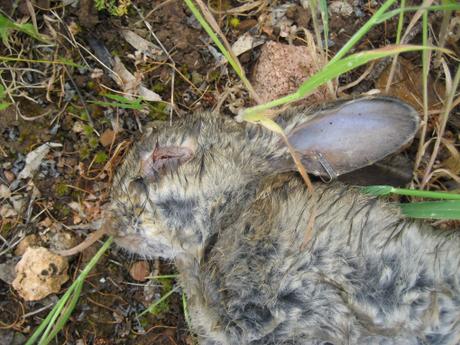
Tagged European rabbit kitten infected with myxoma virus, but that died from rabbit haemorrhagic virus disease (RHDV). Photo by David Peacock, Biosecurity South Australia.
“Canberra, we have a problem” — Sure, it’s an old problem and much less of one than it used to be back in the 1950s, but invasive rabbits are nonetheless an ecological, conservation, and financial catastrophe across Australia.
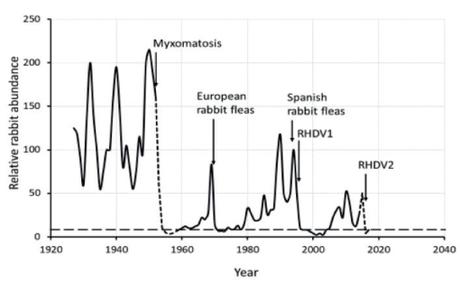
Semi-schematic diagram, redrawn using data from Saunders and others and extended to include the recent spread of RHDV2, showing changes in rabbit abundance in relation to the introduction of biological control agents into north-eastern South Australia. Dotted lines indicate uncertainty due to lack of continuous annual data. The broken line indicates a level of about 0.5 rabbits ha-1, below which rabbits must be held to ensure recovery of native pastures and shrubs (from B. Cooke 2018 Vet Rec doi:10.1136/vr.k2105)
Rabbits used to reach plague numbers in much of agricultural and outback Australia, but the introduction and clever manipulation of two rather effective rabbit-specific viruses and insect vectors — first, myxoma virus in 1950, European rabbit fleas in the 1960s to help spread the virus, then Spanish rabbit fleas in the 1990s to increase spread into arid areas, and then rabbit haemorrhagic disease virus (RHDV) in 1995 — have been effective in dropping rabbit abundances by an estimated 75-80% in South Australia alone since the 1950s.
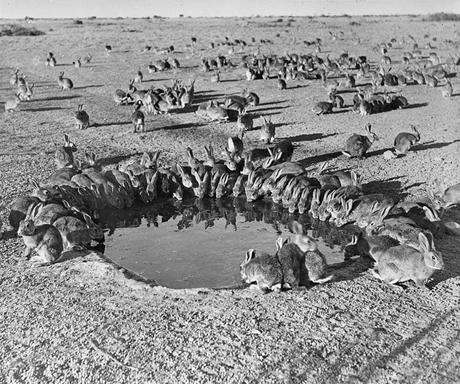
Rabbits around a waterhole at the myxomatosis trial enclosure on Wardang Island in 1938. See page for author [Public domain], via Wikimedia Commons
While the arrival of a RHDV variant (RHDV2) in 2015 has complicated matters, the end result is an evolving and interacting cocktail of rabbit diseases that are keeping rabbits in much of the continent under some control.
But how are they interacting? This was one of the main questions we’ve recently addressed in a new paper that just came out online in Journal of Applied Ecology entitled ‘Previous exposure to myxoma virus reduces survival of European rabbits during outbreaks of rabbit haemorrhagic disease‘. Led by Dr Louise Barnett formerly of the Global Ecology Laboratory at Flinders University, and with substantial modelling and writing contributions from Dr Thomas Prowse of the University of Adelaide, this paper represents a great applied collaboration between academia (also including Ron Sinclair of University of Adelaide and Brian Cooke of University of Canberra) and government — in this case, Biosecurity South Australia (David Peacock, Greg Mutze, John Kovaliski).
Using data from what I am led to believe is one of the longest-running monitoring programmes in disease ecology — the > 21-year Turretfield Rabbit Research Project run by Biosecurity South Australia — personnel censused, bioassayed (for virus exposure), and released rabbits of all ages from a more-or-less demographically closed (i.e., no net emigration or immigration) population approximately every two months.
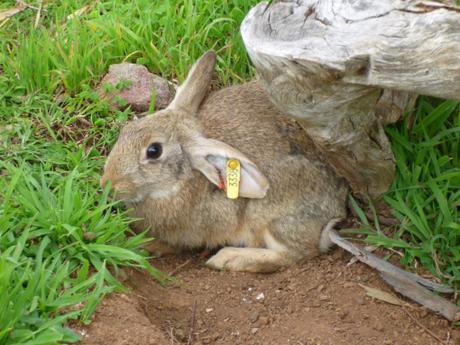
Tagged rabbit from Turretfield (photo taken 8 September 2014). This individual had no antibodies to RHDV or myxoma virus, but was moribund (i.e., in the process of dying). Two hours after this photo was taken, the rabbit was dead. Photo by David Peacock (Biosecurity South Australia).
From this unprecedented database, Louise and the rest of us developed multi-state mark-capture-recapture models in the R version of Program MARK (RMark) to determine the probability of transitioning between different age categories and disease states. We explicitly tested the hypothesis that being exposed to one disease altered the probability of dying from another.
And that’s when we discovered that the probability of dying from RHDV was 10% higher than expected when an individual rabbit had been previously exposed to myxoma virus. In other words, the population-level effects of the two diseases were interactive, not just additive (i.e., 1 + 1 = 2.1).
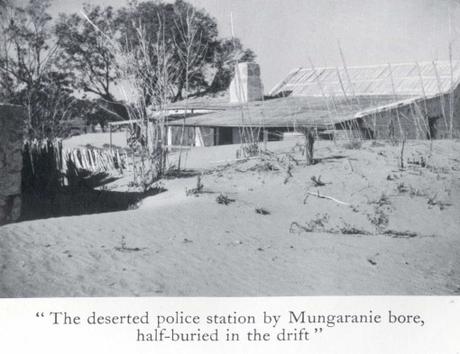
Why was myxomatosis introduced to Australia? Because rabbits were doing this to farms in the latter part of the 19th and early 20th Centuries. Photo by Francis Ratcliffe (one of CSIRO’s first ecologists).
In essence, we showed that the contribution of the two rabbit biocontrols has given us more bang for our buck via this interactive effect. Rarely has such an interaction between two diseases been shown, and we think our discovery is the first of its kind between two biocontrols. If you are someone tasked with biocontrol, then this is the sort of hard evidence you need to justify continued work for multiple, interacting disease solutions to limit the damage from invasive species.
The economic benefits of better biocontrol are beyond doubt — some estimates for the agricultural benefits of rabbit biocontrol in Australia since 1950 are at least AU$70 billion. But there are many other benefits to reduced densities of rabbits in Australia. Rabbits are, of course, herbivores, so they compete for food with native wildlife and they damage native vegetation (and thus, habitat quality). Rabbits are also a diet mainstay for two of Australia’s most damaging invasive species — feral cats (Felis catus) and red foxes (Vulpes vulpes) — so, a large rabbit population can keep the two predator species at high densities as well, thus promoting high predation rates on native wildlife.
In fact, the rate of native vegetation cover has increased since the spread of RHDV1 from 1995, and there have been documented increases in the abundance of small native mammal species since that time.
Better, ecologically informed biocontrol is therefore just another smart way to manage invasive species.

